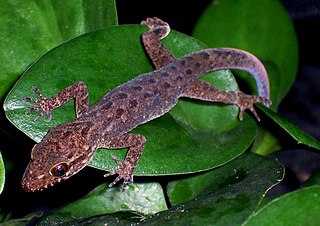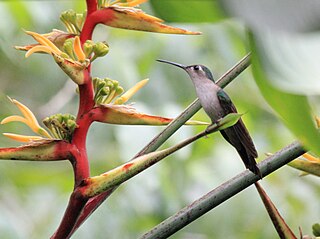
Cyrtodactylus is a diverse genus of Asian geckos, commonly known as bent-toed geckos, bow-fingered geckos, and forest geckos. The genus has at least 300 described species as of 2020, which makes it the largest of all gecko genera.

The sac spiders of the family Clubionidae have a very confusing taxonomic history. Once, this family was a large catch-all taxon for a disparate collection of spiders, similar only in that they had eight eyes arranged in two rows and conical anterior spinnerets that touched, and were wandering predators that built silken retreats, or sacs, usually on plant terminals, between leaves, under bark, or under rocks. These are now recognized to include several families, some of which are more closely related to the three-clawed spiders, like lynx and wolf spiders, than to Clubionidae and related families.

The mourning warbler is a small songbird of the New World warbler family. Mourning warblers are native to eastern and central North America as well as some countries in Central America. They are neotropical migrants and tend to be found in dense second growth forests. They are under the Wood-warbler category, which consists of arboreal and terrestrial colorful passerines. Wood warblers are in the order Passeriformes, which are perching birds including more than half of all bird species, and the family Parulidae which also includes the Common Yellowthroat, Black and White Warbler, Nashville Warbler, ovenbird, and American Redstart. They are very similar to the MacGillivray's Warbler in appearance, especially in females and immature birds, but their breeding range does not overlap into the west.

Pyramidellidae, common name the pyram family, or pyramid shells, is a voluminous taxonomic family of mostly small and minute ectoparasitic sea snails, marine heterobranch gastropod molluscs. The great majority of species of pyrams are micromolluscs.

The southern crested newt is a terrestrial European newt. It is similar to the northern crested newt except larger and more robust.

The wedge-tailed sabrewing is a species of hummingbird in the family Trochilidae. It is found in Belize, Guatemala, Honduras, and Mexico. Its natural habitats are subtropical or tropical moist lowland forest and heavily degraded former forest.

Onchidorididae are a taxonomic family of sea slugs, dorid nudibranchs, marine gastropod molluscs in the superfamily Onchidoridoidea.

Australia has a number of highly venomous spiders, including the Sydney Funnel-web, its relatives in the family Hexathelidae, and the Redback Spider, whose bites can be extremely painful and have historically been linked with deaths in medical records. Most Australian spiders do not have venom that is considered to be dangerously toxic. No deaths caused by spider bites in Australia have been substantiated by a coronial inquest since 1979. There are sensationalised news reports regarding Australian spiders that fail to cite evidence. A Field Guide to Spiders of Australia published by CSIRO Publishing in 2017 featuring around 836 species illustrated with photographs of live animals, around 381 genera and 78 families, introduced significant updates to taxonomy from Ramirez, Wheeler and Dmitrov

Nyssus coloripes, known as the orange-legged swift spider, is a spider belonging to the family Corinnidae. It is found commonly in Australia and New Zealand.
The Reptile Database is a scientific database that collects taxonomic information on all living reptile species. The database focuses on species and has entries for all currently recognized ~13,000 species and their subspecies, although there is usually a lag time of up to a few months before newly described species become available online. The database collects scientific and common names, synonyms, literature references, distribution information, type information, etymology, and other taxonomically relevant information.

Indolestes gracilis is a species of damselfly in the family Lestidae. It is known only from Sri Lanka, South India and Cambodia.

Trachelidae is a family of araneomorph spiders first described by Eugène Simon in 1897 as a subfamily called "Tracheleae". The Trachelidae family, also known as "ground sac spiders", is within the group of spiders known as the RTA clade, which includes mostly wandering spiders that do not use webs. Spiders in the Trachelidae family are characterized as being 3-10mm long and having a red cephalothorax and a yellow/tan abdomen. They are commonly found indoors. It was placed in the family Clubionidae, then later in Corinnidae when the Clubionidae were split up. The first study that suggested Trachelidae should be considered its own family was done by Deeleman-reinhold in 2001 as part of an analysis of RTA Clade spiders. An analysis by Martín J. Ramírez in 2014 suggested that it was not closely related to other members of the Corinnidae, and was better treated as a separate family. It was then placed in the CTC clade of spiders, or the Claw Tuft Clasper clade, which is a group of spiders that have two tarsal claws with tufts of hair.
Utivarachna is a genus of Asian araneomorph spiders in the family Trachelidae first described by Kyukichi Kishida in 1940. It was largely ignored until Christa L. Deeleman-Reinhold revised the sac and ground spiders in 2001, transferring some species from Trachelas and adding several new ones. The genus was further expanded in 2014 and 2015.

Elaver is a genus of sac spiders first described by Octavius Pickard-Cambridge in 1898.
Elaver madera is a species of spider in the spider family Clubionidae. It was first named Clubionoides madera when circumscribed in 1966. It is closely allied to Elaver texana and its related species, which are mostly found in the American tropics.
Elaver chisosa is a species of spider in the spider family Clubionidae. It was first named Clubionoides chisosa when circumscribed in 1966.
Clubiona marna is a species of spider in the spider family Clubionidae. It was first circumscribed in 1966.
Elaver excepta is a species of sac spider in the family Clubionidae. It is found in North America and the Caribbean.











